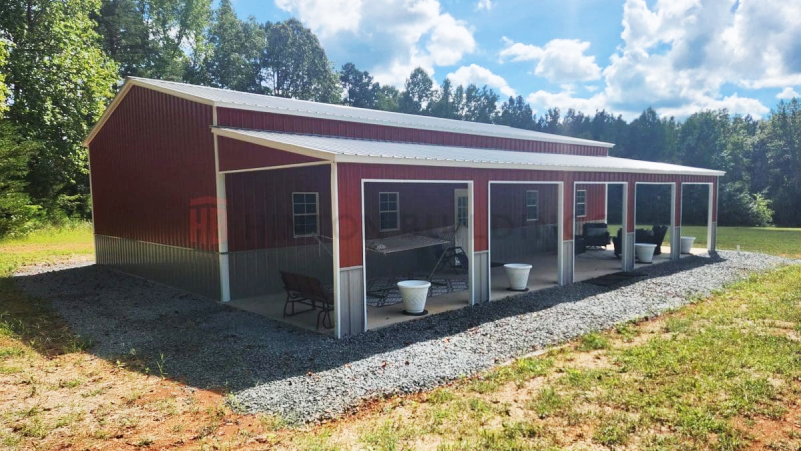
Wood sheds aren’t just practical storage spaces. They can also be charming additions to your garden or backyard. However, staining is essential to keep them looking their best and protect them from the elements. If you’re wondering how to stain your wood shed, you’ve come to the right place.
In this comprehensive guide, we’ll cover everything you need to know about staining, from the types of wood stains to the art of application. Let’s get started!
Before you begin staining, you must understand the different types of wood stains available and their advantages and disadvantages. The three primary types of wood stains are water-based, oil-based, and gel.
Water-based stains are popular for their quick drying times and easy cleanup. These stains are eco-friendly and produce minimal odor, making them an environmentally conscious choice. However, water-based stains do not penetrate as deeply into the wood as oil-based stains, which means you may have to reapply it more frequently.
Oil-based stains are known for their durability and deep penetration into the wood fibers. They provide a rich, long-lasting finish that enhances the natural beauty of the wood. However, they take longer to dry and emit strong fumes, so proper ventilation is essential during application.
Gel stains offer the best of both worlds. They have a thick, jelly-like consistency that prevents them from dripping, making them easier to apply on vertical surfaces. Gel stains provide excellent coverage and are available in various colors. However, they may require more effort to achieve an even finish compared to water-based and oil-based stains.
When selecting a wood stain for your shed, consider factors such as weather conditions, wood type, and desired finish.
For sheds exposed to harsh weather, oil-based stains are recommended due to their superior durability. However, if you prefer a quick-drying option, water-based stains are ideal. In contrast, gel stains are perfect for achieving an even finish on vertical surfaces.

Preparation is key to achieving a flawless stained finish. Follow these steps to prepare your wood shed for staining:
Start by thoroughly cleaning the wood surface to remove dirt, dust, and any existing finish. Use a mild detergent mixed with water and a scrub brush to clean the shed. Rinse off the soap residue with clean water and allow the wood to dry completely.
Next, sand the wood surface to create a smooth and even base for the stain. Use medium-grit sandpaper (around 120 to 150 grit) to sand the entire shed. Pay special attention to rough or uneven areas. Sanding removes imperfections and helps the stain adhere better to the wood.
Inspect the shed for any signs of damage, such as cracks, holes, or loose nails. Before applying the stain, fill cracks and holes with wood filler and sand them down once dry. Ensure that all nails and screws are secure to prevent any movement during the staining process.
Now that your shed is prepped, it’s time to apply the wood stain. Here are some techniques to achieve an even and professional finish:
Brushing is a popular method for applying wood stain as it allows for precise control. Use a high-quality brush with natural bristles for oil-based stains and synthetic bristles for water-based stains. Dip the brush into the stain, and apply it evenly along the wood grain. Work in small sections to avoid overlapping, and use long, smooth strokes for a consistent finish.
Rolling is an efficient technique for covering large areas quickly. Use a foam or microfiber roller for best results. Pour the stain into a paint tray and load the roller evenly. Apply the stain in long, even strokes, following the direction of the wood grain. Be mindful of any drips or excess stain, and promptly smooth them out with the roller.
Spraying is ideal for achieving a uniform finish on intricate surfaces. Use a paint sprayer designed for wood stains, and follow the manufacturer’s instructions. Hold the sprayer at a consistent distance from the surface, and apply the stain in thin, even coats. Be cautious of overspray, and work in a well-ventilated area.
Achieving an even finish when staining your wood shed is crucial for the appearance and function of the stain. To ensure an even finish, follow these tips:
By ensuring an even application, you not only enhance the visual appeal of your wood shed but also extend its lifespan, making it a worthwhile investment for your outdoor space.

After putting in the effort to stain your wood shed, you must maintain its appearance and protection over time. Here are some tips for caring for your stained shed:
By following these care tips, you can enjoy a beautifully stained wood shed for years to come.
Staining your wood shed is a rewarding project that enhances its appearance while providing essential protection. By understanding different types of wood stains, properly preparing the surface, and using effective staining techniques, you can achieve a stunning and long-lasting finish.
If you’re looking for high-quality wood buildings, check out Hinton Buildings today. Our wood storage sheds look great and are sure to have something for your needs!
